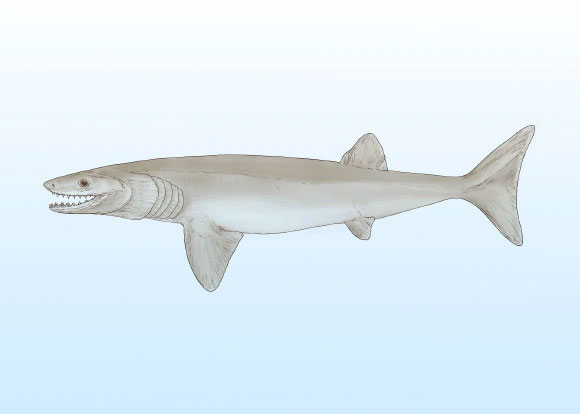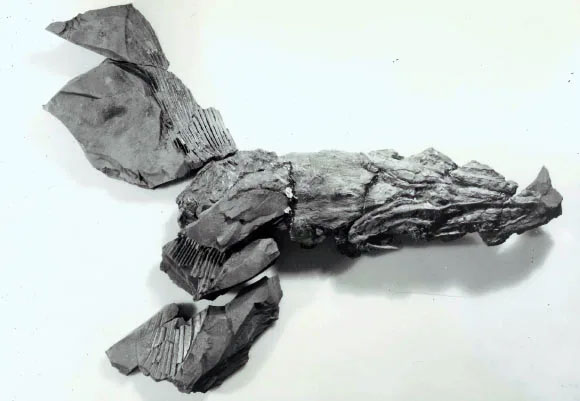Discovering a 324 million-year-old shark 'born from the dead' in the US
The mysterious shark rose from the dead world after the Devonian extinction, with a completely strange anatomical structure compared to modern sharks.
According to Sci-News, the strange shark is named Cosmoselachus mehling . It is one of many well-preserved fossil sharks from the Fayetteville Shale Formation , which stretches from southeastern Oklahoma to northwestern Arkansas in the United States.

A completely new shark species of the Carboniferous period - (Graphic photo: AMERICAN MUSEUM OF NATURAL HISTORY)
Unearthed in the state of Arkansas, it lay dormant in a stone slab dating back 326 million years, or from the Carboniferous period.
Thus, this shark belongs to the class of creatures "born from the dead" , rising and occupying ecological niches left vacant after the previous great extinction at the end of the Devonian period.

Parts of the fossil were collected - (Photo: AMERICAN MUSEUM OF NATURAL HISTORY)
According to a research team led by paleontologists from California State Polytechnic University, Cosmoselachus mehling is a completely new species of shark and also belongs to a new genus.
At the time it existed, the ancient oceans were teeming with cartilaginous fish with incredible morphological diversity, including all kinds of strange anatomical structures that we don't see in modern sharks. .
In fact, its fossil samples were collected in the 1970s by professors Royal and Gene Mapes of Ohio University (USA), but at that time scientists did not realize it was a new species.
In this new study, paleontologists took CT scans and digitally reconstructed the specimen, thereby delicately describing each small piece of cartilage.
After reassembling them and comparing them with other early cartilaginous fishes, they realized it was something completely different.
This new species plays an important role in understanding the evolution of a mysterious group linked to modern-day sharks and ratfish.
This new species is largely shark-like, but has long pieces of cartilage forming the operculum, something only seen in ratfish today.
Therefore, it most likely belongs to a common ancestral branch between the two species, as well as helping to explain the origin and an important stage in the family tree of sharks - one of the lineages that survives. at the oldest on the planet.
The new research has just been published in the scientific journal Geodiversitas.
- Detection of giant shark fossils 300 million years
- Catch a shark with a body like a snake, a mouth of 300 teeth
- Accidentally picked up 3 million year old treasure on the coast
- Unexpectedly discovered fossil teeth Megalodon 8cm long when walking the dog
- Discover the oldest white shark nursery
- Top 15 strangest shark species on the planet
- Japan's artificial womb technology has raised shark embryos until birth
- Shark sanctuary on the Pacific Ocean
- The discovery of fossil shark eggs dates back to 310 million years
- Traces of 2.5 million-year-old 'beast' sharks appear ... in the middle of the city
- The truth about the giant shark that dominated the deep sea for more than 20 million years
- Big sharks eat small sharks
 Discovered an ancient centipede fossil 99 million years old
Discovered an ancient centipede fossil 99 million years old Discovered bat-like dinosaurs in China
Discovered bat-like dinosaurs in China Discovered a 200-year-old bronze cannon of the coast
Discovered a 200-year-old bronze cannon of the coast Discover 305 million-year-old spider fossils
Discover 305 million-year-old spider fossils